Gateway FPD2485W: 24" LCD Beauty or Beast?
by Jarred Walton on February 22, 2007 10:00 AM EST- Posted in
- Displays
Features - OSD
One of the more interesting aspects of this LCD is its On-Screen Display (OSD). Depending on how you intend to use the LCD, you may find yourself accessing the OSD infrequently or on a regular basis. If you use multiple inputs, you will use the OSD to select among the various connected devices. We definitely get the impression that Gateway was trying to make a "cool" OSD. Rather than having actual buttons, the right black border hides touch sensitive areas that light up when you press the menu option.
The initial press of the menu button brings up several quick access options to get you to the most commonly used areas. At the top is a "scrollable" area where you can select among several different color themes: movie, web, picture, game, warm, cool, and user. These options basically adjust the brightness, contrast, and color levels to preset values, with the exception of "user" which is for user-defined adjustments. The next four options provide quick access to input selection, picture in picture settings, and video adjustments. The bottom option takes you to the main menu, which is necessary in order to reach a few other areas.
Choosing among the six available inputs is pretty simple. After exiting the Input Select option, you choose the appropriate input and you're done. The currently active input is not listed, which is why there are only five inputs shown - we used the DVI input for most of our testing. It's a bit odd that they don't simply put the sixth input in place of the Cancel option, however, so that all of the menu items would always be in the same position.
Outside of the initial menu and input selector, the way the On-Screen Display functions changes - somewhat counter-intuitively, we might add. The remaining menus move the various options into a gray area on the left side of the OSD, and the top "scroll" buttons are now used to move up and down among the options. These buttons aren't particularly sensitive, so sometimes you will tap a button and get no result while other times you will push it once and the selection will jump twice. Above you can see the images of the Picture, PIP, and Advanced menus; the various submenus are self-explanatory and we didn't bother capturing screenshots taking pictures.
The final two OSD menus contain items related to adjustment of signal properties. If you are using a digital connection, several of the items are grayed out - Sharpness, Noise Reduction, Film Mode, and Video Enhance all deal with improving the quality of analog signals. Video Scaling allows you to customize how non-native resolutions are handled, including the option of displaying the content at a one-to-one ratio (unscaled). The Panoramic function is a nonlinear stretch that is only available with analog connections.
The OSD certainly provides all of the options we like to see, but navigating through the various menus is not quite as straightforward as we would like. This is due in part to the less sensitive "scroll" buttons at the top of the menu - or at least they didn't seem to be quite as responsive as the other menu buttons. If you find yourself frequently accessing the OSD menus, it can be a little irritating at times, and it seems like things could have been made easier by turning the "scroll" area into a couple more buttons and eliminating the need to move up and down among the various options. Still, the OSD does provide a good set of adjustments, and while it could have been streamlined it works well enough to get the job done.
One of the more interesting aspects of this LCD is its On-Screen Display (OSD). Depending on how you intend to use the LCD, you may find yourself accessing the OSD infrequently or on a regular basis. If you use multiple inputs, you will use the OSD to select among the various connected devices. We definitely get the impression that Gateway was trying to make a "cool" OSD. Rather than having actual buttons, the right black border hides touch sensitive areas that light up when you press the menu option.
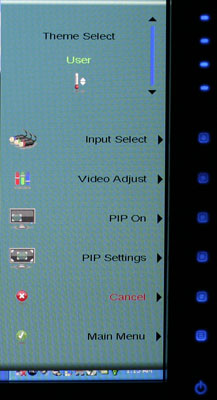 |
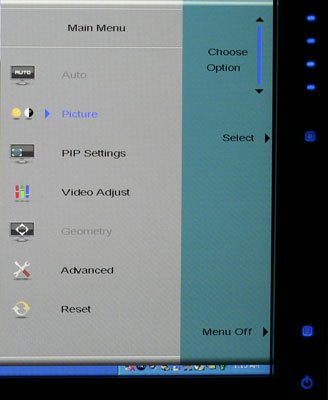 |
| Click to enlarge | |
The initial press of the menu button brings up several quick access options to get you to the most commonly used areas. At the top is a "scrollable" area where you can select among several different color themes: movie, web, picture, game, warm, cool, and user. These options basically adjust the brightness, contrast, and color levels to preset values, with the exception of "user" which is for user-defined adjustments. The next four options provide quick access to input selection, picture in picture settings, and video adjustments. The bottom option takes you to the main menu, which is necessary in order to reach a few other areas.
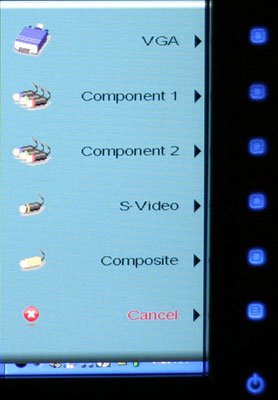 |
| Click to enlarge |
Choosing among the six available inputs is pretty simple. After exiting the Input Select option, you choose the appropriate input and you're done. The currently active input is not listed, which is why there are only five inputs shown - we used the DVI input for most of our testing. It's a bit odd that they don't simply put the sixth input in place of the Cancel option, however, so that all of the menu items would always be in the same position.
 |
 |
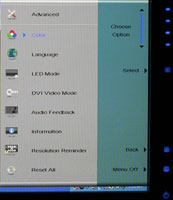 |
| Click to enlarge | ||
Outside of the initial menu and input selector, the way the On-Screen Display functions changes - somewhat counter-intuitively, we might add. The remaining menus move the various options into a gray area on the left side of the OSD, and the top "scroll" buttons are now used to move up and down among the options. These buttons aren't particularly sensitive, so sometimes you will tap a button and get no result while other times you will push it once and the selection will jump twice. Above you can see the images of the Picture, PIP, and Advanced menus; the various submenus are self-explanatory and we didn't bother capturing screenshots taking pictures.
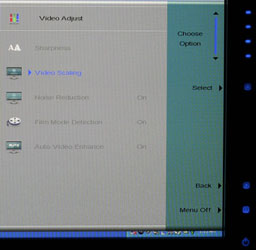 |
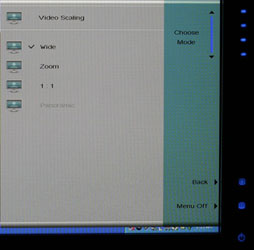 |
| Click to enlarge | |
The final two OSD menus contain items related to adjustment of signal properties. If you are using a digital connection, several of the items are grayed out - Sharpness, Noise Reduction, Film Mode, and Video Enhance all deal with improving the quality of analog signals. Video Scaling allows you to customize how non-native resolutions are handled, including the option of displaying the content at a one-to-one ratio (unscaled). The Panoramic function is a nonlinear stretch that is only available with analog connections.
The OSD certainly provides all of the options we like to see, but navigating through the various menus is not quite as straightforward as we would like. This is due in part to the less sensitive "scroll" buttons at the top of the menu - or at least they didn't seem to be quite as responsive as the other menu buttons. If you find yourself frequently accessing the OSD menus, it can be a little irritating at times, and it seems like things could have been made easier by turning the "scroll" area into a couple more buttons and eliminating the need to move up and down among the various options. Still, the OSD does provide a good set of adjustments, and while it could have been streamlined it works well enough to get the job done.










77 Comments
View All Comments
strikeback03 - Friday, February 23, 2007 - link
You skipped quoting the rest of the paragraph:Optimal brightness setting for LCDs is often stated to be 120 cd/m^2. So in many circumstances the extra brightness of the Gateway isn't useful.
JarredWalton - Friday, February 23, 2007 - link
400 cd/m2 is the most I could imagine using, and once both LCDs were adjusted the actual white point was a lot closer - meaning even though the maximum on the Gateway was twice as high, once calibrated I didn't use anywhere near that white level. 300+ cd/m2 can be almost painful to look at in my opinion, and 400 or higher is generally overkill.The point is, the only reason Gateway and others seem to have such insane brightness levels is to get better contrast scores. Most people will run around 200 cd/m2, give or take probably 50. But if your black is only able to reach a minimum of 0.35 cd/m2, that means the contrast ratio would be somewhere between 500:1 and 600:1. The "solution" is to simply crank up the maximum brightness, so you can claim a 1000:1 (or even 1200:1) contrast ratio. More is better, right? Except, it's not, because hardly anyone will actually use those super-bright whites.
Also worth noting is that if you max out brightness and contrast (max white level), the color accuracy scores go to hell and the whites all run together, so everything from about 200 or higher on the RGB scale ends up as the same level of white. At maximum contrast, the recommended calibrated brightness (according to Monaco Optix) is 20%, where if I choose 60 contrast the recommended brightness is 61%. As mentioned in the review, the overall color accuracy was better with contrast set to 60 as opposed to 100.
The maximum brightness (100% contrast) was even higher than reported: 500 cd/m2 was pretty close, but black went up to 0.45 cd/m2. Depending on the room you work in, higher brightness may be okay or not. I prefer running closer to 200-300 personally.
DigitalFreak - Friday, February 23, 2007 - link
All I can say is that I love my 2405!Painman - Friday, February 23, 2007 - link
Besides the already requested input lag tests, modern LCD reviews usually include at least a few gaming tests... some commentary on what kind of visual artifacts are evident with fast moving objects. I had 3 of these Gateways (returned for various defects) and tried to like it, but aside from other problems the smearing was just too much to take... green and brown smudges always popping up in my face. I bought myself an IPS based NEC and I ain't looking back.This isn't a very good gamer panel... thinking about it now sitting in front of this NEC, I can't really say the Gateway FPD2485W is a good ANYTHING panel, tbh.
Aquila76 - Friday, February 23, 2007 - link
If you want to see something that'll blow your mind on this display, fire up HL2. At the menu screen, where it's out of focus as it loads the game, it looks like you've dropped to 256 Color mode and are 'dithering' the image. I noticed the same effect when hitting the Nitro in a couple Need for Speed games.knirfie - Friday, February 23, 2007 - link
This monitor features DCDi by Farudja, why is there no mention of this in the review (or did I miss it?). And how is the videoquality/deinterlacing over composite/svideo/component?DigitalFreak - Friday, February 23, 2007 - link
Page 3:Souka - Friday, February 23, 2007 - link
get an apple cinema display and make sure its calibrated properly....nothing better IMHO... use them all the time at work. Some folk have those Dell units...yuk....color is off, things seem dull, despite all calibration attempts.
Good thing they're just doing web page design and programming....
dcr - Thursday, February 22, 2007 - link
Could you test WoW and see if you get this "flashing" in the terrain?chizow - Thursday, February 22, 2007 - link
Jarred, nice review of the 2485W, was wondering if you wouldn't mind posting your settings after you calibrated your display with Optix. Reason I ask is that myself and many others felt the color accuracy out of the box on this panel were horrible, especially compared to other displays. I was able to get better results by asking what settings people were using, and obviously what looks good to them will vary person to person and card to card, but it was a big help.Also, it might be worth noting what month your panel was made. There were some serious issues with this panel in early production runs (November), but each successive month seems to correct problems and greatly reduce other problems. Backlight bleed seems to greatly diminish as well as an annoying PSU buzzing problem with newer models.
Lastly, I was glad you mentioned the 1:1 pixel mapping, but I think there needs to be greater emphasis on this aspect of 24" panels or any panel able to do 1920x1080. In the era of HD with all of the inputs this monitor and some competitor models provide (BenQ, Dell Rev. A04), the ability to do 1:1 is a major consideration for the enthusiast. If you have multiple HD capable devices (HDTV, PS3, Xbox360, HD-DVD, Blu-Ray) this monitor can basically serve as your entertainment center, all while maintaining its main functionality as a massive 2.3 Megapixel PC display. There's really few other tech-enabling devices I've purchases that can compete with this panel's versatility and functionality.